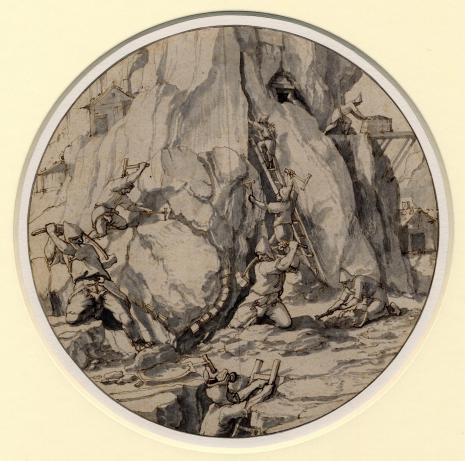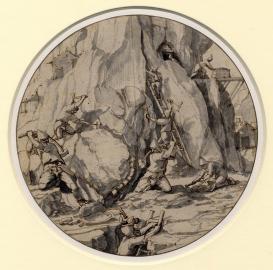Mining, metallurgy, and monetary practices are fields of knowledge and areas of action that are widely discussed in economic history, history of economic thought, history of science, and environmental history but rarely in way that makes these connections visible. Sixteenth and seventeenth century mining is an apt context for exploring knowledge in and of the Anthropocene for three reasons. First, it was a site where geological and economic processes were thought to interlock and therefore an area of keen scientific interest. Second, it was a sector that was considered to be of particular importance for early modern territories as it provided the source material of monetary circulation. Third, it was here that human action and technology transformed nature in fundamental ways, triggering early reflection by contemporaries on the consequences of their actions.

After Hans Holbein the Younger, Mining Scene, drawing 225x225mm, 1590-1600 (circa). British Museum, London, Reg. No.1872, 1012.3315.
Mining was one of the most important driving forces behind economic and technological dynamics in early modern Europe. Silver, copper, and lead mining experienced a veritable boom in the Ore Mountains, the Harz Mountains, and the Tyrolean Alps from the second half of the fifteenth century. The rapid spread of news of the discovery of rich metal deposits led to a sudden transformation of hitherto uncultivated areas into populated and prospering mining regions. Contemporaries coined the term Berggeschrey (mining clamor) to describe this phenomenon. It points to a process of economic dynamism, with faster cycles of booms and busts, the circulation of people, knowledge, materials, and money. The clamor’s intensity and impulsiveness marks also the affective dimension of this early modern silver rush, driven by material desires, greed, hope, and fear.
Through the perspective of the concept of Berggeschrey, the project linked the history of political economy—broadly understood as the set of practices of making and exchanging value in a given culture—with questions about knowledge, agency, and meaning being raised within the histories of science and art. It could be shown how contemporary processes of valuation of metals are not just restricted to mere economic dimensions but acknowledge the complex semantics of the material and their emotional-affective implications. Conflated notions of gold and silver, both as symbols and generators of value, act as a starting point for analyzing discourses on material transformations, abundance, and shortage, desires, hopes, and fears as well as negotiations of price and value.

